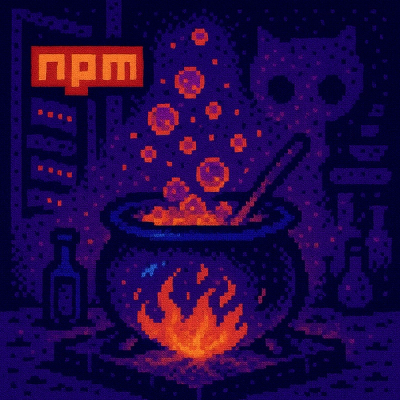
Security News
The Changelog Podcast: Practical Steps to Stay Safe on npm
Learn the essential steps every developer should take to stay secure on npm and reduce exposure to supply chain attacks.
node-redis is a modern, high performance Redis client for Node.js.
Learn for free at Redis University
Build faster with the Redis Launchpad
Start a redis via docker:
docker run -p 6379:6379 -d redis:8.0-rc1
To install node-redis, simply:
npm install redis
"redis" is the "whole in one" package that includes all the other packages. If you only need a subset of the commands, you can install the individual packages. See the list below.
| Name | Description |
|---|---|
redis | The client with all the "redis-stack" modules |
@redis/client | The base clients (i.e RedisClient, RedisCluster, etc.) |
@redis/bloom | Redis Bloom commands |
@redis/json | Redis JSON commands |
@redis/search | RediSearch commands |
@redis/time-series | Redis Time-Series commands |
@redis/entraid | Secure token-based authentication for Redis clients using Microsoft Entra ID |
Looking for a high-level library to handle object mapping? See redis-om-node!
import { createClient } from "redis";
const client = await createClient()
.on("error", (err) => console.log("Redis Client Error", err))
.connect();
await client.set("key", "value");
const value = await client.get("key");
client.destroy();
The above code connects to localhost on port 6379. To connect to a different host or port, use a connection string in
the format redis[s]://[[username][:password]@][host][:port][/db-number]:
createClient({
url: "redis://alice:foobared@awesome.redis.server:6380",
});
You can also use discrete parameters, UNIX sockets, and even TLS to connect. Details can be found in the client configuration guide.
To check if the the client is connected and ready to send commands, use client.isReady which returns a boolean.
client.isOpen is also available. This returns true when the client's underlying socket is open, and false when it
isn't (for example when the client is still connecting or reconnecting after a network error).
There is built-in support for all of the out-of-the-box Redis commands. They are exposed
using the raw Redis command names (HSET, HGETALL, etc.) and a friendlier camel-cased version (hSet, hGetAll,
etc.):
// raw Redis commands
await client.HSET("key", "field", "value");
await client.HGETALL("key");
// friendly JavaScript commands
await client.hSet("key", "field", "value");
await client.hGetAll("key");
Modifiers to commands are specified using a JavaScript object:
await client.set("key", "value", {
EX: 10,
NX: true,
});
Replies will be transformed into useful data structures:
await client.hGetAll("key"); // { field1: 'value1', field2: 'value2' }
await client.hVals("key"); // ['value1', 'value2']
Buffers are supported as well:
const client = createClient().withTypeMapping({
[RESP_TYPES.BLOB_STRING]: Buffer
});
await client.hSet("key", "field", Buffer.from("value")); // 'OK'
await client.hGet("key", "field"); // { field: <Buffer 76 61 6c 75 65> }
If you want to run commands and/or use arguments that Node Redis doesn't know about (yet!) use .sendCommand():
await client.sendCommand(["SET", "key", "value", "NX"]); // 'OK'
await client.sendCommand(["HGETALL", "key"]); // ['key1', 'field1', 'key2', 'field2']
Start a transaction by calling .multi(), then chaining your commands. When
you're done, call .exec() and you'll get an array back with your results:
await client.set("another-key", "another-value");
const [setKeyReply, otherKeyValue] = await client
.multi()
.set("key", "value")
.get("another-key")
.exec(); // ['OK', 'another-value']
You can also watch keys by calling
.watch(). Your transaction will abort if any of the watched keys change.
In v4, RedisClient had the ability to create a pool of connections using an "Isolation Pool" on top of the "main"
connection. However, there was no way to use the pool without a "main" connection:
const client = await createClient()
.on("error", (err) => console.error(err))
.connect();
await client.ping(client.commandOptions({ isolated: true }));
In v5 we've extracted this pool logic into its own class—RedisClientPool:
const pool = await createClientPool()
.on("error", (err) => console.error(err))
.connect();
await pool.ping();
See the Pub/Sub overview.
SCAN results can be looped over
using async iterators:
for await (const key of client.scanIterator()) {
// use the key!
await client.get(key);
}
This works with HSCAN, SSCAN, and ZSCAN too:
for await (const { field, value } of client.hScanIterator("hash")) {
}
for await (const member of client.sScanIterator("set")) {
}
for await (const { score, value } of client.zScanIterator("sorted-set")) {
}
You can override the default options by providing a configuration object:
client.scanIterator({
TYPE: "string", // `SCAN` only
MATCH: "patter*",
COUNT: 100,
});
The QUIT command has been deprecated in Redis 7.2 and should now also be considered deprecated in Node-Redis. Instead
of sending a QUIT command to the server, the client can simply close the network connection.
client.QUIT/quit() is replaced by client.close(). and, to avoid confusion, client.disconnect() has been renamed to
client.destroy().
client.destroy();
Node Redis v5 adds support for Client Side Caching, which enables clients to cache query results locally. The Redis server will notify the client when cached results are no longer valid.
// Enable client side caching with RESP3
const client = createClient({
RESP: 3,
clientSideCache: {
ttl: 0, // Time-to-live (0 = no expiration)
maxEntries: 0, // Maximum entries (0 = unlimited)
evictPolicy: "LRU" // Eviction policy: "LRU" or "FIFO"
}
});
See the V5 documentation for more details and advanced usage.
Node Redis will automatically pipeline requests that are made during the same "tick".
client.set("Tm9kZSBSZWRpcw==", "users:1");
client.sAdd("users:1:tokens", "Tm9kZSBSZWRpcw==");
Of course, if you don't do something with your Promises you're certain to
get unhandled Promise exceptions. To take
advantage of auto-pipelining and handle your Promises, use Promise.all().
await Promise.all([
client.set("Tm9kZSBSZWRpcw==", "users:1"),
client.sAdd("users:1:tokens", "Tm9kZSBSZWRpcw=="),
]);
See the Programmability overview.
Check out the Clustering Guide when using Node Redis to connect to a Redis Cluster.
The Node Redis client class is an Nodejs EventEmitter and it emits an event each time the network status changes:
| Name | When | Listener arguments |
|---|---|---|
connect | Initiating a connection to the server | No arguments |
ready | Client is ready to use | No arguments |
end | Connection has been closed (via .disconnect()) | No arguments |
error | An error has occurred—usually a network issue such as "Socket closed unexpectedly" | (error: Error) |
reconnecting | Client is trying to reconnect to the server | No arguments |
sharded-channel-moved | See here | See here |
:warning: You MUST listen to
errorevents. If a client doesn't have at least oneerrorlistener registered and anerroroccurs, that error will be thrown and the Node.js process will exit. See the >EventEmitterdocs for more details.
The client will not emit any other events beyond those listed above.
Node Redis is supported with the following versions of Redis:
| Version | Supported |
|---|---|
| 8.0.z | :heavy_check_mark: |
| 7.4.z | :heavy_check_mark: |
| 7.2.z | :heavy_check_mark: |
| < 7.2 | :x: |
Node Redis should work with older versions of Redis, but it is not fully tested and we cannot offer support.
If you'd like to contribute, check out the contributing guide.
Thank you to all the people who already contributed to Node Redis!
This repository is licensed under the "MIT" license. See LICENSE.
ioredis is a robust, performance-focused, and full-featured Redis client for Node.js. It supports Redis Cluster, Sentinel, pipelining, Lua scripting, and more. Compared to the 'redis' package, ioredis offers a more modern interface with Promises support and better performance for certain operations.
node-redis is another Redis client for Node.js that is designed to be easy to use. It may not have as many features as 'redis' or 'ioredis', but it provides a straightforward way to interact with Redis servers for simple use cases.
redis-mock is a library that simulates a Redis server for testing purposes. It implements most of the Redis commands and can be used as a drop-in replacement for the 'redis' package during testing, without the need for an actual Redis server.
FAQs
A modern, high performance Redis client
The npm package redis receives a total of 4,095,661 weekly downloads. As such, redis popularity was classified as popular.
We found that redis demonstrated a healthy version release cadence and project activity because the last version was released less than a year ago. It has 5 open source maintainers collaborating on the project.
Did you know?

Socket for GitHub automatically highlights issues in each pull request and monitors the health of all your open source dependencies. Discover the contents of your packages and block harmful activity before you install or update your dependencies.

Security News
Learn the essential steps every developer should take to stay secure on npm and reduce exposure to supply chain attacks.

Security News
Experts push back on new claims about AI-driven ransomware, warning that hype and sponsored research are distorting how the threat is understood.

Security News
Ruby's creator Matz assumes control of RubyGems and Bundler repositories while former maintainers agree to step back and transfer all rights to end the dispute.